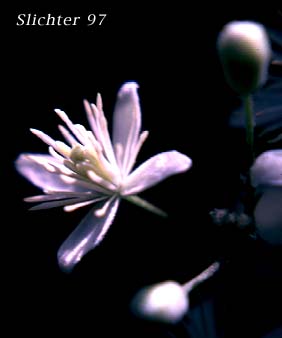 Western clematis from
the Corbett Exit from Interstate 84, near Corbett, OR.....August 1991.
Western clematis from
the Corbett Exit from Interstate 84, near Corbett, OR.....August 1991.
Western clematis is also known as white virgin's bower, traveler's joy, and pipestems. It is a weedy, trailing to climbing vine with multiple stems arising up to 15 meters in length from a central clump. The woody stems may be as much as 10 cm wide at the base. The pinnately compound leaves typically have 3-7 ovate leaflets with several-toothed margins, which may be partly cleft or parted. Individual leaflets are 3-6 cm long.
The flowers are in leafy-bracted paniclulate cymes. Individual flowers are either male or female, the female flowers with both functional pistils and infertile stamens and the male flowers with stamens only. The sepals are white,narrowly oblong-lanceolate in shape, 8-12 mm long and covered with woolly hairs. The sepals may be ascending, spreading or reflexed. The achenes are densely villous with feathery talus from 2.5-3 cm long.
Western clematis is also similar to the introduced Clematis vitalba in the Puget Sound area, but the latter plant has flowers with both male and female parts functioning and 3 leaflets with entire margins or the terminal leaflet shallowly 3-lobed.
The feathery seed heads were once used by the pioneers to provide a soapy lather. I see some native plant nurseries which sell this species, but I'd advise caution using it in plantings as it tends to vine its way up into adjoining shrubbery or trees and eventually shade them out. It is also difficult to eradicate once established in the shrubbery border.
Western clematis is found in sagebrush, ponderosa pine, and mixed forests, frequently along creek bottoms. It seems to frequently pop up in human disturbed environments.
Western clematis is found from southern British Columbia southward along the east base of the Washington Cascades, then west into the Columbia River Gorge. It is found on both sides of the Oregon Cascades and may be found as far south as southern California. It ranges eastward to New Mexico and North Dakota.